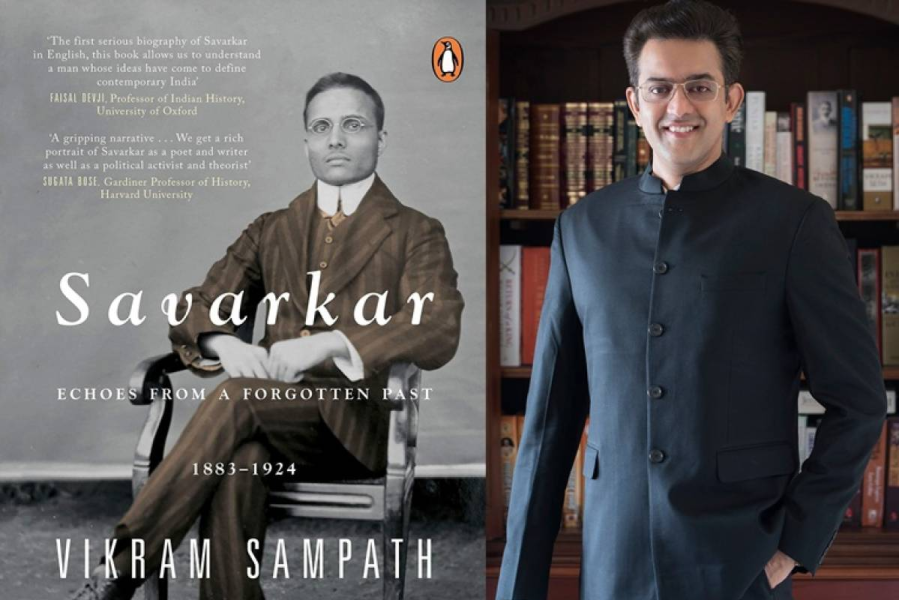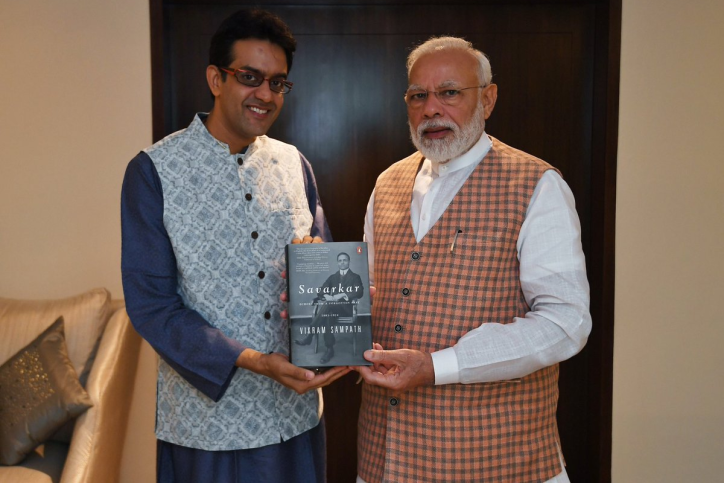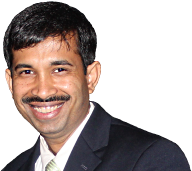The name Vinayak Damodar Savarkar (aka Veer Savarkar) doesn’t mean much in the minds of Indian people these days, other than a notion that there is some controversy around this name that politicians stoke around the election period.
The author of the biography of V.D. Savarkar named Savarkar: Echoes from a Forgotten Past, Vikram Sampath says in the prologue itself, the name of Savarkar or any details about him is conspicuously absent from all our history textbooks across India. After reading this book, one thing is obvious to the reader, as the author also confirms, the post-colonial political powers in India did not wish the young people of the country to know anything about Savarkar and his legacy. And they succeeded so far!

The left-liberal cabal of historians and media who seem to have infiltrated all influential institutions with the help of political powers has ensured that one can hardly get anything positive about Veer Savarkar if he tries to search even his name on the internet. Amidst all the propaganda, Vikram Sampath brings a very comprehensive and rare biography of Savarkar that carries details of his fascinating life story, description of the tumultuous times of our history, and presents us with a comprehensive account of Vinayak Damodar Savarkar’s eventful journey through this book.
Being an avid reader, I have read many great biographies and autobiographies. But this is by far the only biography I couldn’t rest until finished once I got started. Going through Savarkar’s life from just an ordinary little boy to becoming a multi-talented young man, to becoming a threatening figure for the almighty British Empire who needed to get rid of him anyhow, to his deportation from England to India to be sentenced to a 50-year jail term on fabricated charges, to his transfer to Cellular Jail at Port Blair and his suffering there is a heart-wrenching reading experience that gives a feeling of nothing less than a thriller!
Vikram Sampath has done an extraordinary job of research and extensive study to develop this biography. He describes Savarkar in his prologue in this way:
As the intellectual fountainhead of the ideology of Hindutva, which is in political ascendancy in India today, Vinayak Damodar Savarkar is undoubtedly one of the most contentious political thinkers and leaders of the twentieth century. Accounts of his eventful and stormy life have oscillated from eulogizing hagiographies to disparaging demonization. The truth, as always, lies somewhere in between and has unfortunately never been told the people of this country.
What should get your attention from this description is that he did have a stormy life. That means this book will take you on an emotional roller coaster with thrilling details of the kind of storms Savarkar created and some that he experienced himself.
Now, as a reader, let me share with you a few insights that I got to know about Savarkar from this book in terms of his personality, his thought process, and his leadership style.
Veer Savarkar was a Ferocious Reader
One thing that you notice throughout the book is that Savarkar had an amazing appetite for reading. He read history books, literature, philosophy, Vedic literature, political and social news, contemporary discourses, and anything else that could add to his vast knowledge repository. He also had a curiosity to learn from world affairs, world history, and people worldwide who walked before him.
Throughout the book, numerous examples demonstrate his knowledge of books from various fields and then application of that in his mission and strategies. He did not just read; he learned and applied that knowledge wherever he found an appropriate use of it.
One of the examples of that skill of young Savarkar shows up early on when he created a strategic dual-faced organization where the front-facing organization ‘Mitra Mela’ was used to conduct public events like mela, festivals, etc. to screen, filter, and then recruit suitable and trustworthy candidates for the armed revolution against the British which was the secret society (the inner circle). It was a brilliant move strategically borrowed from his knowledge of Thomas Frost’s work ‘Secret Societies of European Revolution 1776-1876’.
Veer Savarkar was an Amazing Orator, Author, and a Poet
When you read this biography, you realize that the sheer amount of literature, books, and poems that Veer Savarkar wrote and published is overwhelmingly impressive. The quality of his writing was an inspiration for all his contemporaries and many revolutionaries!
One of his creations, the iconic patriotic hymn, ‘Jayostute’ that he wrote in 1903, was recorded in the voice of none other than late The Nightingale of India, Lata Mangeshkar, and broadcasted post-independence on All India Radio.
You can watch/listen to the full recording of the video here at Youtube:
As an author, Veer Savarkar wrote several books in Marathi and English. The book titled “The Indian War of Independence, 1857” printed around 1908-09 became his most famous creation, which was banned by the British Administration even before it was published. Publishing that book itself is a fascinating story that has taken about 4-5 pages of writing space for Vikram Sampath. It was a mission impossible just to get the book published due to the British ban. Yet Savarkar got it finally printed and sold across the globe despite all the British attempts to block it. This is one of the books that became a source of inspiration for many freedom fighters in the future, including the late Sardar Bhagat Singh!
Veer Savarkar was a Legendary Patriot and Revolutionary
Even though Savarkar was younger than Mahatma Gandhi in age, he was much senior as a revolutionary. When Gandhi was in Africa serving the British with loyalty, young Savarkar already had become a serious threat to the British Empire through the activities of Abhinav Bharat, his revolutionary organization.
While Savarkar was all for the armed revolution against the British, he had a very balanced approach to it. In one of his writings around the early days, he wrote that Abhinav Bharat called for total freedom and armed revolution was inevitable means to get it. However, the excess of hyper-nationalism is just as dangerous as the complete lack of it. Savarkar quoted Bhagavad Gita to explain when to use force and when to use negotiations or non-violence. He said that the nation must always be good to its people.
Veer Savarkar was in England when Madan Lal Dhingra killed Curzon Wyllie in London in 1909. He did so not for any personal reason but to demonstrate his opposition to the British atrocities in India, as evident from the speech Dhingra gave in the courtroom. Interestingly, the entire Indian community and prominent leaders of the time, such as Gopalkrishna Gokhle, began condemnations of Dhingra, including his parents and siblings disowning him. We can only imagine what could have been the reasons for these condemnations! However, there was one man who made news by opposing the resolution to declare Dhingra as ‘criminal’. That man was none other than young Savarkar himself, who not only opposed the move but did so very smartly to evade any legal trouble. Newspapers in England recognized Savarkar as ‘a fervent nationalist…an extremely brilliant scholar…and a political theorist…deeply versed in all the literature of political liberty.
The story of Veer Savarkar is filled with his relentless efforts to organize and awaken the Indian people against the British through his writing by providing material and logistical support for the armed revolution from London to Paris to India. However, his writing, at the time of his transportation to the Andaman Islands after getting 50 years of jail term on the fabricated charges of sedation, shows his mindset and what he was thinking when there was no hope of him ever returning to see his motherland. I only want to quote the part that shows how deep patriotism ran in his veins.
He writes his thoughts of the time he was being transported to the steamer in Madras:
Thousands looking at me in this plight were simply indifferent and altogether cold. They were looking at me as they would have seen any corpse passing along the road. ‘Poor man, he is dead and gone!’ says the passer-by and forgets him the next moment. It was a pain to me to see them gaping at me –my fellow countrymen that they were… If but a single one out of these my compatriots was to tell me, ‘Go, my brother, go, I and others like me swear that we shall make India free and fulfill your vow’, I would have felt my funeral bier as soft as a bed strewn with flowers.
Such deep patriotism ran in his veins, and such was his commitment to his motherland. Most Indians have no clue because these facts have been intentionally hidden from all Indians by the ruling class and the people in power.
Veer Savarkar was Against Forced Religious Conversions
Savarkar suffered inhuman jail treatment for about 21 years in the Andaman Islands at the Cellular Jail, and even that did not break him. He was a reformer at heart and did what he could to make things better for the prisoners there, and in the long run, after many struggles, he did succeed in bringing positive changes even there.
While imprisoned, Savarkar noticed how Muslim warders and Jamadars in the Cellular Jail mistreated Hindu prisoners, used foul language towards Hindu scriptures, banned them from even keeping Hindu scriptures/books. In contrast, Muslim prisoners were given many provisions. Savarkar also noticed a consistent trend of torturing Hindu prisoners until they agreed to switch their faith just to be able to avoid the pain of torture. The book describes these episodes in detail.
Savarkar registered an official complaint against these coercive conversions, and he was continuously harassed for it. There were even multiple attempts on his life right there in the jail too. Initially, he did not know how to deal with these conversions, how to stop them, or what to do with the people who converted under fear and intimidation.
But it was during this period that Savarkar thought of the efforts of Swami Dayanand Saraswati and the ‘Shuddhi’ movement of the Arya Samaj. This was the solution to the problem of forced conversions, he thought and began the work, despite all odds, all the opposition and eventually prevailed. This was the seed that transformed a young, radical revolutionary into a strategic planner during his period at the Cellular Jail, who went on to dedicate the rest of his life to organizing Hindu society with the vision to return the nation to regain the lost glory.
There were other issues within the Hindu community, such as the issue of untouchability which Savarkar fought vigorously during his entire life. He was a Brahmin himself, and few people realize that he started reforms to eradicate untouchability from the Hindu society long before Ambedkar. In that area, at least he should be given as much credit as Dr. Ambedkar (if not more) for his dedication to this cause and the number of changes he brought in this area of Hindu society.
Veer Savarkar Opposed Appeasement Policy of Gandhi and Congress
Gandhi had strengthened his grip on Congress with the launch of his controversial Khilafat movement, for which he has been eternally criticized. Savarkar denounced that as ‘Aafat’ warned that it was a movement that was going to create more problems for India and bound to destroy the power of the country.
Savarkar’s denunciation had come to fruition, and one of the most tragic results of Gandhi’s Khilafat movement was the blood-curdling atrocities committed Moplahs of the Malabar in August 1921, where a band of fanatic Muslims caused havoc against the helpless Hindu community. News of mass-murdering Hindus, brutal rapes of women in front of their family members, the killing of pregnant women, desecration of temples, cow slaughter, forcible conversions, and lootings continued until British troops took control after some time. Many unspeakable, horrific acts of atrocities that Hindus faced are documented in this book.
In response to the news, Gandhi spoke of Moplahs as brave, God-fearing patriots who were fighting for what they considered as a religion and in a manner that they considered as religious. Gandhi went on to add that Hindus must find the causes of Moplah fanaticism, and then they will find that Hindus are not without blame. Therefore, according to Gandhi, it was not fair to be angry at the Moplahs or Muslims in general. The Congress committee, which was under the heavy influence of Gandhi, also did not condemn Moplahs for their atrocities.
Dr. Ambedkar’s reaction to this is evident when he writes:
Any person could have said that this was too heavy a price for Hindu-Moslem unity. But Mr. Gandhi was so much obsessed by the necessity of establishing Hindu-Moslem unity that he was prepared to make light of the doings of the Moplahs and the Khilafats who were congratulating them…
While still in jail, Savarkar strongly condemned the barbarity of the Moplahs and the cowardly behavior of the Congress, just to save their movement. He wrote several essays and articles warning about the dangers of the Khilafat and pan-India Islam movement. He lamented that most Hindus were not even aware of the history of political Islam or its theology.
Savarkar remained critical of Gandhi and his philosophy of non-violence. In an obvious rebuttal of Gandhi’s non-violence, he took the example of Buddhism, whose expansion had been disastrous for the Indian nation because of its philosophy of non-violence. He said that Buddhism had nothing to offer against violent outsider invaders, so the country fell when it did. Non-violence was answerless when pitted against armed and violent invaders and outsiders who were inferior to Indians in all other human traits.
More details of Savarkar’s work on Hindutva, nationalism, social reforms, and the ‘Shuddhi‘ movement are discussed in the second volume of the book, for which I plan to write another post on this blog. This book covers his journey from being just a freedom fighter to recognizing the future challenges and strategically using the intellectual tool to combat the narrative that Gandhi and Congress were plotting in India that he considered detrimental to the country and the fight for freedom at that time.
Veer Savarkar’s Work on Nationalism and Social Reforms
As Vikram notes, Veer Savarkar despised the caste system right from his childhood, though he was born in a Brahman family. During his long and agonizing jail time, he penned several essays on the abhorrent practice of the caste system and untouchability that plagued the nation—advocating a strong case for their total, complete and unconditional eradication at a time when these ideas were not yet a part of political discourse either by Gandhi or Ambedkar. Savarkar was the first leader to envision and advocate a casteless India when none of the famous leaders spoke of it.
He was all for modernization of society, and breaking the shackles of the past dogmas in Hindus and Muslims alike was necessary. His writing on nationalism, Hindutva, science, cinema, Cow Protection, and untouchability is way ahead of his times. A lot more of those are shared in the second volume of Vikram’s book, which I will share in the future. But the life of Savarkar and his thought process and conduct shared in this book is a delight just to know how clearly he thought and how he acted way ahead of his time.

No wonder decades after he is gone, he is the only Indian leader/revolutionary from his time who remains a point of discussion and arguments. He was way ahead of his time regarding thought processes and identification of future issues you will notice as you read this biography. Unfortunately, Indians have been deprived of this essential knowledge about one of the greatest freedom fighters of Indian history purposefully by free India’s governments who tried their best to bury Savarkar and his legacy unjustly.
At this time, I am thrilled to realize that even though it has been too late, I am finally in awe to learn about one of the great Veer Savarkar. My respect for this legendary and visionary knows no bounds.
Having read the true history of Veer Savarkar, I can say with an absolute conviction that this is a must-read book for every Indian. What is taught in our history textbooks is just propaganda by those who want to remain relevant by hiding the truth from the masses. The Real History of India’s freedom struggle that is fed to our children in schools is either a lie or a half-truth. The life of Veer Savarkar and this book is just proof of that.
Last but not least, I would like to share this video of the author of Savarkar’s biography, Vikram Sampath, who shares a lot of information from the book, provides a lot of context and color around Savarkar’s life events shared in this book and also his perspective as a historian about Veer Savarkar’s legacy, his life, writings and much more. Please do take time and watch this excellent talk before you leave:
You can buy a copy of the book (English) from Amazon.com by going to this link: Savarkar: Echoes from a Forgotten Past.
Your Turn To Share
Now that I have shared with you what I learnt from the first book of Veer Savarkar’s biography, I would love to know if you have read this book already? If so, what do you think? What are your insights? Do you recommend any other authentic documents/books on Savarkar? Please feel free to share your thoughts.




